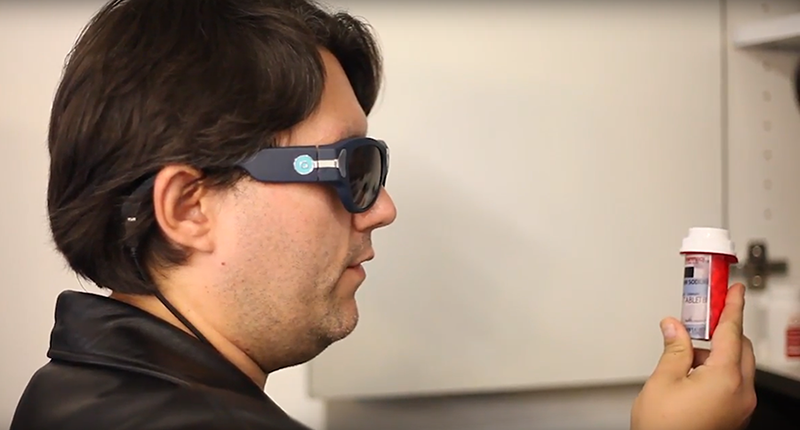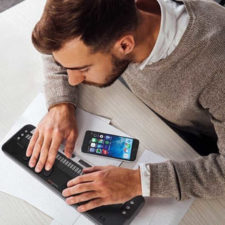OCR Devices for the Blind: Transforming Text into Speech with Ease
Wiki Article
Empowering Freedom With Assistive Innovation for the Blind
The combination of assistive technology right into the lives of people with visual disabilities represents a significant improvement in promoting self-reliance and self-sufficiency. From cutting-edge screen viewers to sophisticated wise canes, these tools not just improve everyday navigation and communication yet additionally empower individuals to engage meaningfully in different elements of life. As we explore the myriad advantages and real-world applications of these technologies, it ends up being crucial to take a look at the underlying factors that add to their effectiveness and the possibility for future growths in this essential area.Review of Assistive Modern Technology

The development of assistive innovation is based in principles of inclusivity and empowerment. Advancements in software program, hardware, and sensory improvements offer users with alternatives customized to their details requirements. From screen readers that convert message to speech, to responsive tools that share information with touch, these tools change the way people engage with their surroundings.
Along with sensible applications, assistive technology promotes higher social inclusion and involvement in different fields, consisting of education and learning and employment (Speech-to-text devices for low vision). As research study and advancement remain to progress, the potential for assistive innovation to further improve the lives of visually impaired individuals stays promising, paving the way for a more fair society where everyone can prosper
Types of Assistive Devices
A selection of assistive tools have actually arised to support people with aesthetic impairments, each made to meet details requirements and improve daily functioning. These gadgets range from low-tech services to sophisticated innovations, offering varied alternatives for users.Low-tech tools consist of magnifiers and large-print products that assist in reading and writing. Braille devices, such as Braille styluses and slates, make it possible for tactile analysis and interaction. Alignment and flexibility aids, like white walking sticks, help customers navigate their atmosphere securely.
On the greater end of the range, digital magnification systems and display viewers provide substantial support. Electronic magnifiers allow individuals to increase the size of message and photos on displays, while screen visitors transform electronic content into manufactured speech, assisting in access to info on computer systems and mobile phones.
Smartphone applications likewise play a vital function, supplying features like text recognition and navigation help. Wearable technology, such as clever glasses geared up with enhanced reality, is becoming a promising tool to enhance situational understanding.
Advantages of Assistive Modern Technology
The assimilation of assistive modern technology significantly boosts the high quality of life for people with aesthetic impairments. These technologies empower customers by promoting self-reliance, enabling them to browse their environments extra effectively and execute day-to-day tasks with higher ease. For circumstances, screen visitors and zoom software application allow people to gain access to electronic details, cultivating specialist and instructional opportunities that might have previously run out reach.Furthermore, assistive tools such as wise walking canes and GPS applications supply real-time navigation support, enhancing flexibility and safety. This enhanced freedom not just improves self-worth however likewise urges social engagement, permitting users to participate more completely in their neighborhoods.
Assistive innovation also promotes communication, aiding customers get in touch with others with voice recognition and text-to-speech applications. This ability is important for maintaining connections and accessing essential info.
In addition, the customization alternatives offered with lots of assistive modern technologies ensure that customers can customize tools to their details requirements, further boosting usability and effectiveness. In general, the advantages of assistive technology for people with visual problems are extensive, advertising a more comprehensive culture where everyone can pursue their objectives and goals.
Study and Success Stories
Highlighting the transformative effect of assistive technology, various study illustrate just how people with aesthetic impairments have efficiently incorporated these devices into their every day lives. One eye doctor open today engaging example entails an university student who used display reading software to browse online sources and scholastic materials successfully. This technology not only facilitated her education yet also boosted her self-confidence in taking part in conversations and group projects.An additional study includes a professional who employs a mobile phone application developed for navigation and object recognition. By utilizing this app, he has actually regained autonomy in both his individual and job environments, enabling him to commute separately and engage with coworkers much more properly.
In addition, a retiree shared her experience with braille e-readers, which allowed her to access a vast selection of literature and stay linked with her neighborhood with publication clubs.
These success stories emphasize the crucial role of assistive modern technology in cultivating freedom, enhancing quality of life, and promoting social assimilation for individuals with aesthetic impairments (Speech-to-text devices for low vision). By accepting these cutting-edge devices, customers can get over difficulties and take opportunities that add to their individual and specialist satisfaction

Future Patterns in Assistive Innovation
Technology in assistive innovation is poised to redefine the landscape of support for people with visual impairments. Emerging trends emphasize the combination of synthetic knowledge (AI) and artificial intelligence, which enhance the functionality of tools that help with navigating and details access. AI-driven applications are currently capable of analyzing visual data in real-time, enabling customers to involve with their atmosphere extra individually.Moreover, the advancement of wearable technology is progressing quickly. Smart glasses furnished with enhanced truth (AR) can offer audio summaries of surroundings, transforming how customers interact with public areas. These gadgets not only promote freedom yet also foster social incorporation.
In Addition, the Web of Points (IoT) is making homes smarter, permitting for seamless connection between everyday devices and assistive devices. This connection encourages users by enabling voice-activated controls and automated actions tailored to private needs.
Conclusion
To conclude, assistive technology plays a crucial function in encouraging individuals with visual problems by improving their self-reliance and involvement with their surroundings. The varied variety of applications and tools offered not only assists in navigating and interaction however additionally advertises social assimilation and possibilities for personal and professional growth. As developments continue in this field, the capacity for enhancing the high quality of life for those with visual disabilities will broaden, promoting greater freedom and empowerment.
Report this wiki page